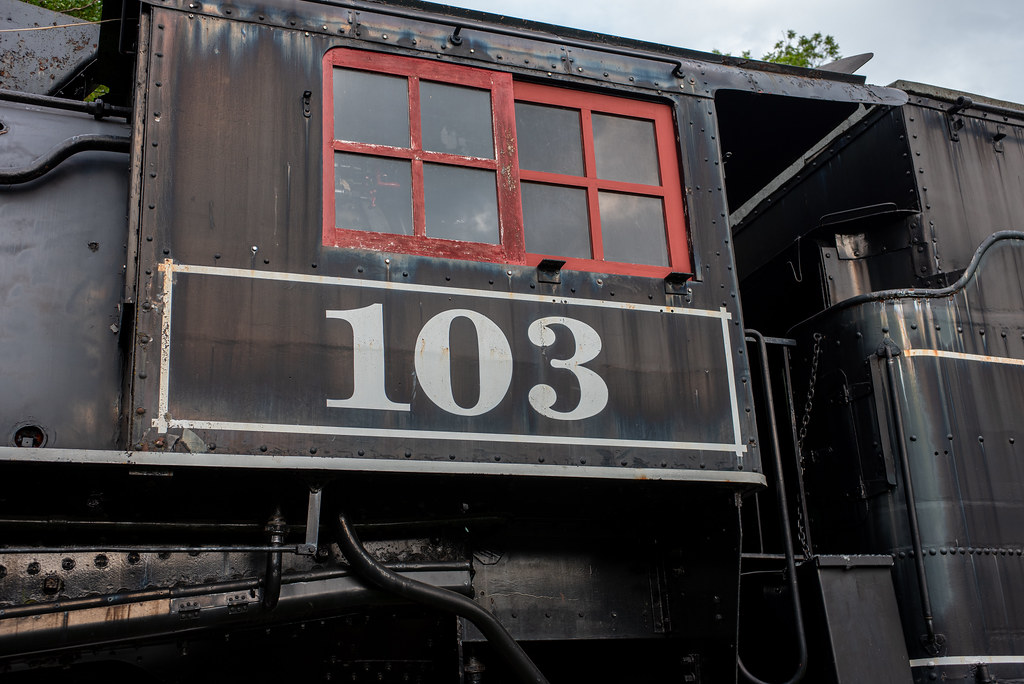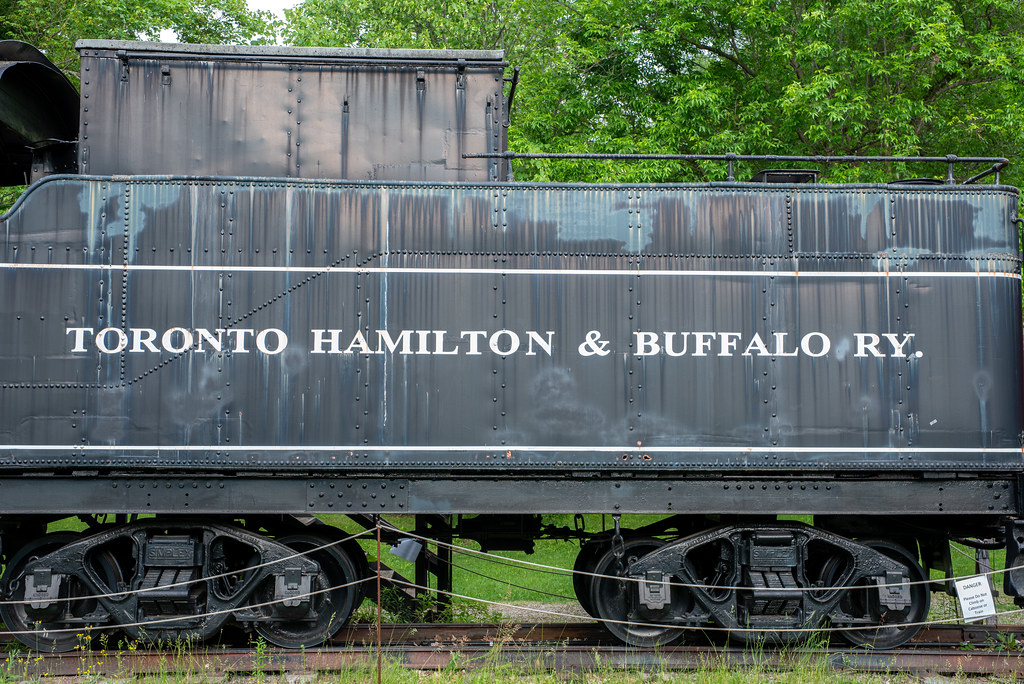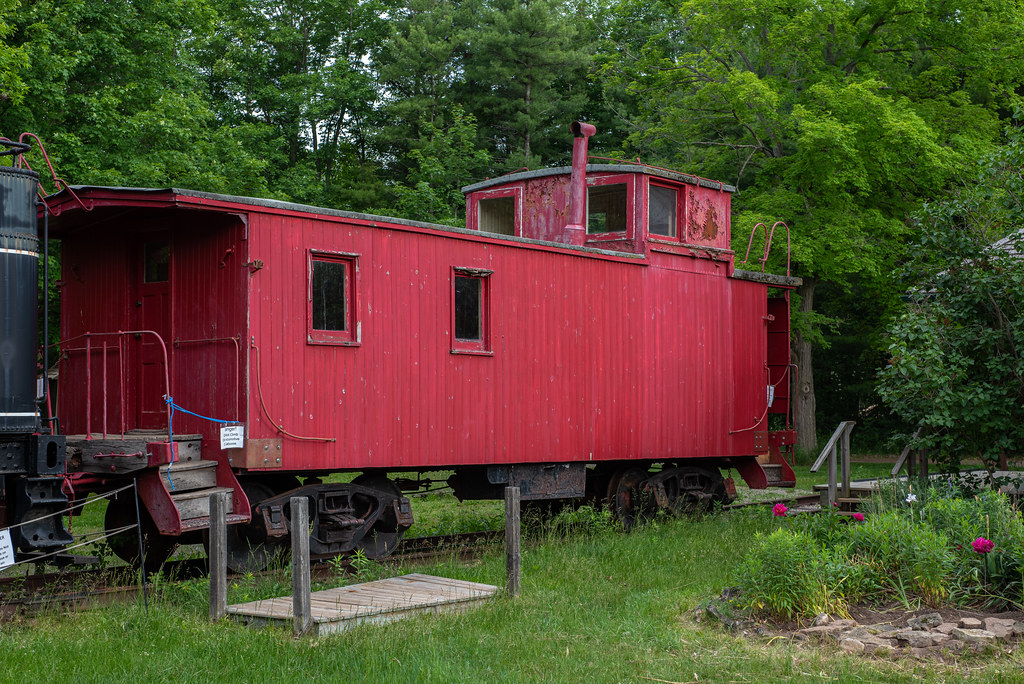One of the jewels in the collection of Westfield Heritage Village is plenty of memorabilia and buildings related to the Toronto, Hamilton & Buffalo Railway. They probably have the second largest collection next to the museum on the second floor of the Hamilton GO Centre. But they do have one thing that the GO Centre does not have, an original locomotive that once served on the Toronto, Hamilton & Buffalo line, Locomotive 103.

Graflex Crown Graphic – Fuji Fujinon-W 1:5.6/125 – Ilford HP5+ @ ASA-200 – Pyrocat-HD (1+1+100) 9:00 @ 20C
The first example of a 2-8-0 saw construction in 1865, an improvement of the 0-8-0 design and completed by John P. Laird for the Pennsylvania Railroad. Originally known as the Bedford, Consolidation quickly became the common class name for future 2-8-0 locomotives. The new Consolidation locomotives were a marked improvement over the older 2-6-0 Mougles and could pull heavier trains and achieve higher speeds. The Consolidation design proved popular, and many locomotive makers began adding these to their product lines, including the American Locomotive Company and Montreal Locomotive Works, who classified them as G-1 locomotives. In 1910, Toronto, Hamilton & Buffalo ordered G-1 locomotives to update their rolling stock. These new engines would be constructed between 1910 through 1913. In total, the operator ordered eleven G-1 locomotives.

Nikon D750 – AF-S Nikkor 28-70mm 1:2.8D
Nikon D750 – AF-S Nikkor 28-70mm 1:2.8D
In 1910, the locomotive with the serial number 48837 rolled out of the Montreal Locomotive Works. It was accepted into the service of the Toronto, Hamilton & Buffalo Railway and received engine number 52. It was assigned to haul heavy freight between Hamilton and Welland and points beyond. It was then renumbered to 72 in 1918 and a year later received the number 103. As a locomotive, 103 served well on the Toronto, Hamilton & Buffalo lines maintained and operated safely. It never once had an accident or failure during its service life. While it did spend most of its time in the Hamilton area, it would travel to points beyond including Toronto and New York but on Canadian Pacific and New York Central tracks. Having proved itself, 103 served until the final days of steam for Toronto, Hamilton & Buffalo. The operator had started switching motive power from steam to diesel-electric on their main lines in 1946 and by 1954 had taken the last steam locomotives out of service. The first operator in Ontario to complete the switch, a good decade before Canadian Pacific and Canadian National. Most of the former Toronto, Hamilton & Buffalo locomotives were sold off to industrial customers, mainly in Hamilton, such as National Steel Car, International Harvester, Steel Company of Canada, and Coke By-Products. Others continued in railway service but for American operators. And many of these ended up getting scrapped. However, 103 giving its excellent record, met a different fate.

Nikon D750 – AF-S Nikkor 28-70mm 1:2.8D
Nikon D750 – AF-S Nikkor 28-70mm 1:2.8D
Giving the close ties between Hamilton and the Toronto, Hamilton & Buffalo Railway, instead of selling 103, they decided to donate it to the city in 1954. The city council gladly accepted the gift but took two years to find a new home for 103. Eventually, it was settled to have the locomotive located in Gage Park near the Roselawn Lawn Bowling Club. The location was well known to rail enthusiasts who watched the Toronto, Hamilton & Buffalo trains that drove past the park. The locomotive got a refresh at the nearby shops, and a set of tracks were laid to allow the engine to be moved from the shops to the prepared concrete pad and tracks. In October 1956, the engine was carefully moved into the park. In a grand ceremony, Hamilton Mayor Lloyd D. Jackson and Fire Chief Reg Swanborough formally accepted the locomotive from Toronto, Hamilton & Buffalo General Manager Percy Hankson. The presence of Chief Swanborough was notable as he had previously worked as a fireman aboard 103. The old steel horse became a local and beloved landmark and was cared for, at least at first. But as the years went on and the city suffered an economic downturn, the financial support for maintaining 103 dried up. It aged under the weather and became a target for vandalism. By the 1970s, the engine seemed doomed to the scrap yard like many before. But before that could happen, the Westfield Pioneer Village expressed an interest in saving the locomotive; they did have at that point the largest collection of Toronto, Hamilton & Buffalo artefacts at their museum and 103 would be an excellent addition next to the Jerseyville Station. The city gladly sold the locomotive for a dollar. The locomotive was moved in two parts, the main engine and the tender; in January 1977, the trip up the Claremont Access taking two hours alone. The locomotive underwent restoration throughout the winter and early spring and was revealed to the public in May. Present at the ceremony was a former engineer of 103, Herb March. After Westfield closed in 1987, the city planned to have 103 moved to the Museum of Steam and Technology. Ironically, that was the same year Toronto, Hamilton & Buffalo ceased to exist. Thankfully, the movie did not have to happen as the museum reopened intact with 103 in place by 1990. In 1997 under the careful direction of Charles Douborough, 103 underwent 1500 hours of restoration work, all completed by Volunteers and reopened refreshed in 2005. Today the engine is again in serious need of help; if you are willing to donate either time or money, you can visit the Westfield fundraising site. Saving 103 is important as it is one of the few surviving Toronto, Hamilton & Buffalo locomotives. Number 42, 0-6-0 B-2 is located in Lindsay, Ontario, and the third, a 4-6-4, is at Steam Town in Scranton, Pennsylvania.